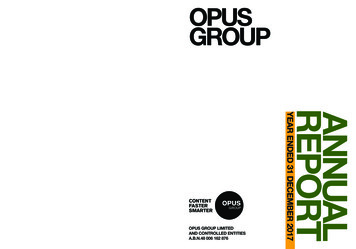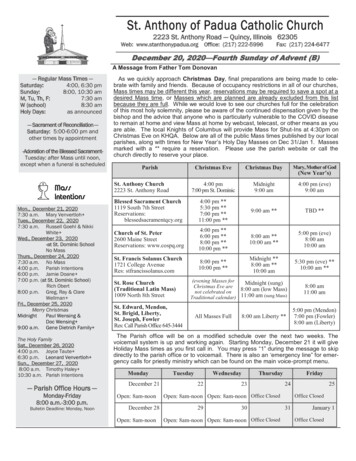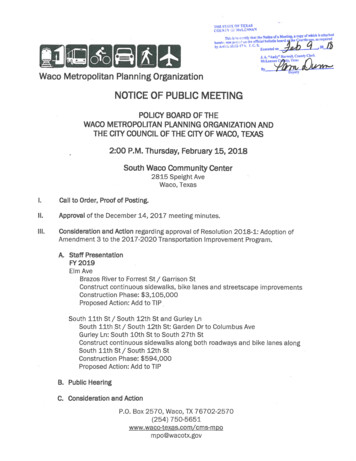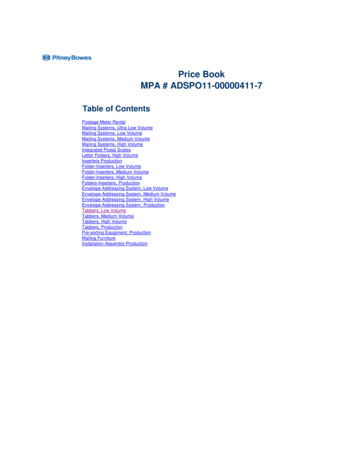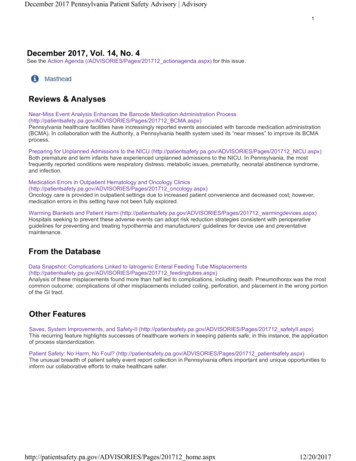
Transcription
December 2017 Pennsylvania Patient Safety Advisory Advisory1December 2017, Vol. 14, No. 4See the Action Agenda (/ADVISORIES/Pages/201712 actionagenda.aspx) for this issue.Reviews & AnalysesNear-Miss Event Analysis Enhances the Barcode Medication Administration es/201712 BCMA.aspx)Pennsylvania healthcare facilities have increasingly reported events associated with barcode medication administration(BCMA). In collaboration with the Authority, a Pennsylvania health system used its “near misses” to improve its BCMAprocess.Preparing for Unplanned Admissions to the NICU 12 NICU.aspx)Both premature and term infants have experienced unplanned admissions to the NICU. In Pennsylvania, the mostfrequently reported conditions were respiratory distress, metabolic issues, prematurity, neonatal abstinence syndrome,and infection.Medication Errors in Outpatient Hematology and Oncology es/201712 oncology.aspx)Oncology care is provided in outpatient settings due to increased patient convenience and decreased cost; however,medication errors in this setting have not been fully explored.Warming Blankets and Patient Harm 12 warmingdevices.aspx)Hospitals seeking to prevent these adverse events can adopt risk reduction strategies consistent with perioperativeguidelines for preventing and treating hypothermia and manufacturers' guidelines for device use and preventativemaintenance.From the DatabaseData Snapshot: Complications Linked to Iatrogenic Enteral Feeding Tube ES/Pages/201712 feedingtubes.aspx)Analysis of these misplacements found more than half led to complications, including death. Pneumothorax was the mostcommon outcome; complications of other misplacements included coiling, perforation, and placement in the wrong portionof the GI tract.Other FeaturesSaves, System Improvements, and Safety-II 12 safetyII.aspx)This recurring feature highlights successes of healthcare workers in keeping patients safe; in this instance, the applicationof process standardization.Patient Safety: No Harm, No Foul? 12 patientsafety.aspx)The unusual breadth of patient safety event report collection in Pennsylvania offers important and unique opportunities toinform our collaborative efforts to make healthcare /201712 home.aspx12/20/2017
Near-Miss Event Analysis Enhances the Barcode Medication Administration Process Advisory2Pa Patient Saf Advis 2017 Dec;14(4).Near-Miss Event Analysis Enhances the Barcode Medication AdministrationProcessAuthorsMary C. Magee, MSN, RN, CPHQ, CPPSSenior Patient Safety/Quality AnalystPennsylvania Patient Safety AuthorityKrista Miller, RPhDirector of Pharmacy ServicesBlue Mountain Health SystemDorothy Patzek, MSN, RNVice President of Nursing/Chief Nursing OfficerBlue Mountain Health SystemCandy Madera, MSN, RNDirector of Staff DevelopmentBlue Mountain Health SystemChristina Michalek, BSc Pharm, RPh, FASHPSenior Medication Safety AnalystPennsylvania Patient Safety AuthorityMegan Shetterly, MS, RN, CPPSSenior Patient Safety LiaisonPennsylvania Patient Safety AuthorityCorresponding AuthorMary C. 201712 BCMA.aspx12/20/2017
Near-Miss Event Analysis Enhances the Barcode Medication Administration Process Advisory3AbstractNear-miss event reporting and analysis is an essential part of a robust patient safety program. Pennsylvania hasseen an increase of more than 2,700% in reports of near-miss barcode medication administration (BCMA) eventsover twelve years, from January 2005 through December 2016. During the same period, events that reached thepatient and caused harm (Serious Events) accounted for only 0.5% of reported BCMA-related events. Reporting, butmore importantly, the analysis of near-miss events can lead to improvements in processes and reduce the potentialfor patient harm. Through a case study, the Pennsylvania Patient Safety Authority shares the story of how BlueMountain Health System reduced its barcode-workflow events by 53% between 2014 and 2016. Through acollaborative effort with the Authority's analysts and patient safety liaison, the health system used near-miss eventreview and analysis to improve its BCMA process. The Authority shares best practice strategies for BCMA use in thecontext of near-miss event analysis.IntroductionThe Lighthouse of Patient SafetyMuch as a lighthouse serves as a navigational aid that warns sailors of hazards and high-risk areas, near-miss eventreporting and analysis can warn facilities about patient safety hazards and system weaknesses before patient harmoccurs. For this article, a near miss has a Pennsylvania Patient Safety Reporting System (PA-PSRS) harm score ofA, B1, or B2. A near miss represents unsafe conditions (i.e., circumstances that could cause an adverse event) or acircumstance that might have caused harm but did not reach the patient because of chance alone or active recoveryefforts by /Pages/201712 BCMA.aspx12/20/2017
Near-Miss Event Analysis Enhances the Barcode Medication Administration Process Advisory4Near-miss event reporting and analysis is common in industries such as aviation, nuclear energy, and chemicalengineering.2-8 It identifies precursor situations and trends in order to prevent the occurrence of harmful and fatalevents. The Institute of Medicine's 1999 report, To Err is Human: Building a Safer Health System, advocated studyingnear misses "to detect system weaknesses before the occurrence of serious harm."9,10 Since then, the PennsylvaniaPatient Safety Authority and others have promoted near-miss event reporting and analysis as part of a robust patientsafety program.10-16 According to an article by Marella, "Near-miss reporting, trending, and data analysis provide anopportunity to take action before someone is injured."10 Further, "if your hospital collects only reports of adverseevents and ignores near-misses, you are missing out on the most valuable source of data for identifying patient safetypriorities and for measuring your progress on the problems you're trying to fix."10In a recently published article, the Authority profiled the Good Catch ratio, a calculation of the number of near-missevents to the number of Serious Events.16 One would expect several near-miss events for each Serious Event.Theoretically, a greater Good Catch ratio may signal a safety culture that values recognition and reporting of hazardsbefore harm occurs.16 Merely reporting and counting events, however, is insufficient without analysis of the data. Inthe case of Blue Mountain Health System, its patient safety liaison (PSL) was cued by an analyst to multiple nearmiss events that occurred within the health system and were categorized as an Other/Miscellaneous event typedescribed as "MAK workflow" (Siemens Med Administration Check ). The analyst determined that these eventswere reported with relative consistency, on a monthly basis, over several months, and appeared to involve themedication administration process.Barcode Medication AdministrationWith the advent and adoption of health information technology (Health IT), such as the electronic health record(EHR), pharmacy computer systems, automated dispensing cabinets, and barcode medication administration(BCMA) systems, complexities are believed to be better managed, albeit not free from workarounds or error.17-20BCMA, an inventory control system, uses barcodes to help prevent medication-administration errors.21-23 Thetechnology is designed to improve the likelihood that the right patient will receive the right medication in the right doseat the right time.22BCMA systems started with U.S. Department of Veterans Affairs (VA) hospitals in the late 1990s and were mostlystand-alone systems that did not integrate with other medication-management technologies.24,25 In 2004, the U.S.Food and Drug Administration (FDA) published its final rule on barcode labels, and manufacturers had until 2006 tocomply with the medication-labeling standards.26Excluding specialty, federal, and VA hospitals, 86% to 93% of U.S. hospitals have adopted BCMA.27,28 In its mostrecent survey published in 2015, the American Society of Health-System Pharmacists reported that "significantincreases [in the number of hospitals using BCMA] were seen in the last five years" and reported a more than 6,000%increase in adoption of BCMA since its 2002 survey.28Blue Mountain Health System, located in northeastern Pennsylvania, includes Gnaden Huetten and Palmertonhospitals.29 In 2007, the health system's leadership committed to system-level organizational changes to become ahigh-reliability organization. The strategies included establishing a culture of safety that prioritized goals that wouldachieve the biggest impact on patient safety. High-risk functions and processes, such as medication management,were chosen as a high priority.30 Health system leadership identified BCMA improvement opportunities and engagedAuthority staff to help improve aspects of the hospitals' BCMA process. Near-miss event review and analysis provedcritical to understanding BCMA workflow at the health system and ultimately led to improvements in medicationadministration s/201712 BCMA.aspx12/20/2017
Near-Miss Event Analysis Enhances the Barcode Medication Administration Process Advisory5Leaders at Blue Mountain Health System noticed a lack of internal near-miss event reporting prior to 2010 andmodified their internal medication-error reports to capture contributing factors. Leadership's commitment to be"obsessed with failure" included focusing on identifying hazards and increasing near-miss event reporting.30 In 2012,the health system upgraded its automated dispensing cabinets to include barcode scan on medication removal for allinpatient nursing units and barcode scan on refill by pharmacy. The bedside barcode scanning application softwareprovided the capability of running medication administration–related reports.MethodsAuthority analysts queried the PA-PSRS database for BCMA events occurring in Pennsylvania healthcare facilitiesfrom January 1, 2005, through December 31, 2016—a twelve-year period adequate to capture a sufficient number ofevents for analysis and spanning the progressive adoption of BCMA implementation in healthcare facilities.The query included all facility types, event types, and care areas. The reporting facilities provided the followinginformation regarding the event: event type, harm score, and event description. Analysts searched free-text datafields for the following key words and phrases, including their variations: barcode, BCMA, and MAK Workflow. Thequery yielded 2,220 events. Analysts manually reviewed all events. Included for analysis were events caught at thepoint of administering the medication to the patient and excluded were 841 events that were not medication barcodeevents, as well as 70 events that were not applicable (e.g., barcode description did not involve the medicationadministration node). This resulted in 1,309 events as the final sample for analysis. Preliminary analysisdemonstrated a relatively large number of reports submitted during 2007; further analysis was conducted to identifywhether one or multiple facilities contributed to this increase.A simple percentage-change formula was used to calculate the percentage increase of PA-PSRS BCMA near-missevents from 2005 to 2016 and the percentage decrease of Blue Mountain Health System's barcode scanning eventsfrom 2014 to 2016.Good Catch RatioThe Good Catch ratio (good catch-to-Serious Event) was calculated by comparing the number of good catch reports(i.e., events submitted with harm scores, A, B1, or B2) to the number of Serious Event reports (i.e., harm scores E, F,G, H, or I), creating a proportion that can be expressed as x:1, or simply x.16Medication ManagementThe medication management process is a series of interdisciplinary, complex tasks that can be divided into five toeight stages or nodes, from selecting a medication through monitoring medication effects on patients.31-34 For thisanalysis, analysts assigned each event to one or more of four applicable nodes: Prescribing Transcribing Dispensing AdministeringLiterature /201712 BCMA.aspx12/20/2017
Near-Miss Event Analysis Enhances the Barcode Medication Administration Process Advisory6Analysts conducted a review of the literature and an internet search to obtain data and information on BCMA,barcode implementation, near-miss event reporting in healthcare and other industries, and workarounds. A medicallibrarian assisted with a search for published articles indexed between January 1, 2011, and December 13, 2016, inthe Association for Computing Machinery, CINAHL, Embase, Google Scholar, Medline, PubMed, and Scopusdatabases. Search terms included the following: automatic data processing, barcodes, BCMA, hospital medicationsystems, implementation, installed, medication errors, workflow, safety management, hazards, and workarounds.Event Details* and Facility-Level DataThe health system's co-authors analyzed data captured in the bedside barcode scanning software application formedication administration,35 and provided the facility-level data that represents the actual number of reportssubmitted to their quality improvement and patient safety committees.The health system's director of pharmacy/medication safety officer reviewed and analyzed this report data andcompiled the results according to the PA-PSRS harm score taxonomy.Blue Mountain Health System's Bedside BarcodeTo assess whether nursing staff was performing barcode scanning at the patients' bedsides, the team analyzedthe bedside barcode scanning application system's data from the medication administration node that correlated withthe right-patient/right-medication scanning step. After standardizing the medication management practices at bothcampuses, the health system team validated that the medication-management processes were improving.* The details of the PA-PSRS event narratives in this article were modified and de-identified to preserve confidentiality. Unless otherwisenoted, none of the event narratives came from Blue Mountain Health System reports.ResultsBarcode Medication Administration Event TrendFigure 1 illustrates an increase in the number of BCMA events reported through PA-PSRS from 2005 through 2016.The increase in 2007 is attributable to a single facility (not a Blue Mountain Health System facility), which accountedfor 86.5% (n 270) of the 312 reports that year. The most recent trend began in 2012, and a spike in reportingoccurred in 201712 BCMA.aspx12/20/2017
Near-Miss Event Analysis Enhances the Barcode Medication Administration Process Advisory7Nodes, Harm, and Near-MissesBCMA events occurred during each node of the medication-management process; 9.9% (n 130 of 1,309) of reportsinvolved more than one node, and therefore, the following percentages will equate to more than 100%. The majorityof events, 81.3% (n 1,064) involved the administering node. The remaining events involved these nodes: Dispensing, 27% (n 354) Prescribing, 1.6% (n 21) Transcribing, 0.8% (n 11)Although all of the events in the sample were identified as BCMA events, 245 did not involve the administering node,as seen in the following example in which the dispensing node was involved and the error was caught duringadministration:The patient was ordered an extended release oral diabetes medication [and the] pharmacy sent [the immediate release version]. Theerror was caught in scanning the barcode.The majority of events, 65.5% (n 857), reached the patient (harm scores C through I; Figure 2). However, onlyseven (0.5%) Serious Events occurred (i.e., resulted in patient harm; harm scores E through I). All of the patient harmevents involved only the administering 201712 BCMA.aspx12/20/2017
Near-Miss Event Analysis Enhances the Barcode Medication Administration Process Advisory8Near-miss events accounted for 34.6% (n 453) of the 1,309 BCMA events and 34.8% of the 1,302 Incidents, asseen in these examples attributed to successful barcode scanning:The pharmacy dispensed the wrong dose of a [dopamine promoter] medication. The error was caught upon barcode scanning. Theintended process functioned as designed. Pharmacy re-dispensed the medication and the patient received the correct dose.The nurse scanned the barcode for the [antibiotic], and the system alerted to wrong medication. Nurse verified with pharmacy that thewrong medication was dispensed. The patient received the correct medication.The Good Catch ratio for BCMA events in this study is 65:1. Interestingly, the Good Catch ratio for the subset of BlueMountain Health System's BCMA events is incalculable because no Serious Events were reported in this studyperiod, compared with the 122 reported near misses.Figure 3 illustrates a 2,725% increase in number of near-miss BCMA events reported through PA-PSRS from 2005 to2016. The increased trend began in 2014 and a spike in reporting occurred in 2015. The percentage increase fromthe start of the trend (2014) is s/201712 BCMA.aspx12/20/2017
Near-Miss Event Analysis Enhances the Barcode Medication Administration Process Advisory9The Blue Mountain Health System's bedside barcode scanning software application allowed for increased datacapture and internal reporting capability. Using these reports, the health system noticed a 172.7% increase in overallmedication-administration error reports (n 77 in 2011 to n 210 in 2012) at the first campus and a 36.4% increase(n 77 in 2011 to n 105 in 2012) at the second campus. In addition, the team determined that the proportion ofnear-miss event reports had increased more than 280% at both campuses, from 20.5% of total reports in 2011 to78.6% in 2012.Figure 4 illustrates Blue Mountain Health System's downward trend (improvement) in near-miss BCMA events. Theoverall improvement is 52.9% from January 2014 to December 201712 BCMA.aspx12/20/2017
Near-Miss Event Analysis Enhances the Barcode Medication Administration Process Advisory10Workflow and WorkaroundsFailure to follow a policy or procedure or employing workarounds was identified in 40.3% (n 527) of the BCMAevents reported through PA-PSRS. Of those 527 events, 83.1% (n 438) reached the patient but only 0.9% (n 5)involved serious harm including death, as seen in these examples:The nurse selected the wrong patient in the computer and administered the medication without checking the patient's ID. The patientwas subsequently transferred to a higher level of care for more frequent monitoring.An RN mistakenly administered an [opioid at four times] the ordered dose. The [construct of the electronic order contained both] theordered dosage and the high-alert dose range. A second RN verified the higher dose with the administering RN before handing over twosyringes. A syringe was scanned after the medication was administered. The patient later died.Of BCMA events, 25.7% (n 337) involved a problem related to equipment, including unreadable patientidentification bracelets, uncharged scanners, missing or smudged barcode labels on medication, and lack of wirelessconnectivity. Fourteen of these equipment-related events also involved staff bypassing policy or procedure.Blue Mountain Health System's Bedside BarcodeAt the health system, the initial percentage of nurses using BCMA for patients at bedside on the inpatient units was97.7%, which increased to 99.6% after one year. Initially 94.1% of the barcode errors occurred during the rightpatient/right-medication step of the administration node; this increased to 97.5% after one year. Examples of thetypes of administration errors included missed doses, delays in medication administration, and wrong-patient scans,including what appeared to be intentional barcode scans of the wrong patient.DiscussionThe number of reports of overall BCMA events reported through PA-PSRS, specifically near-miss BCMA events, istrending higher. The sharp increase in reporting seen in 2007 is likely special cause variation and, as mentioned, isattributable to a single facility. The Authority reached out to the facility responsible for that increase, but as of 201712 BCMA.aspx12/20/2017
Near-Miss Event Analysis Enhances the Barcode Medication Administration Process Advi.11time had not received a response. In comparing Figures 1 and 3, the majority of the 2007 reporting spike seen inFigure 1 is attributable to events with a harm score of C or D, meaning the "event reached the patient but did notcause harm or required monitoring to confirm that it resulted in no harm, and/or required intervention to preventharm."1The 2015 spike in reporting seen in both figures is attributable, in part, to Blue Mountain Health System's eventidentification initiative and reporting. Additionally in 2015, the Authority updated PA-PSRS to collect informationregarding health IT–related contributions to events, as applicable.36The low number of Serious Events compared to Incidents is encouraging. Near-miss events are increasingly beingidentified and reported. Analysis of these "lighthouse" events can alert staff to patient safety hazards and systemweaknesses and, similar to the work shared by the health system, can help identify opportunities to measureprogress on existing initiatives and improve patient safety.Workflow and WorkaroundsA death was reported in which staff bypassed the BMCA procedure. Although the Authority cannot say for certain thatthis death could have been prevented, recognizing when and identifying why staff use workarounds or modifyprocedures to "get the work done" enables leaders to identify hazards and at-risk behavior and potentially redesignthe work.37Blue Mountain Health System and the Authority's Collaboration for ImprovementSimultaneous to the health system's team's tracking and trending of the bedside barcode scanning reports, anAuthority analyst detected and notified the Authority PSL of a pattern of "MAK workflow"-related near-miss reportssubmitted by the health system. The PSL was invited to observe the facility's BCMA workflow and identified systemand process opportunities.The health system's near-miss reporting results appeared to indicate an intentional barcode scan of the wrongpatient. For example, patient A should have been scanned, but Patient B was scanned instead. The error report wasgenerated because the nurse had the wrong patient on the bedside barcode scanning application computer screen.The barcode scanning report caught this discrepancy, and when the Authority's PSL observed medicationadministration workflows, she found that nursing staff was not clearing the previous patient from the barcodescanning system before scanning the next patient, because staff found this procedure modification more efficient(fewer mouse clicks).As is common with BCMA and other health information technologies, a given task may be performed multiple wayswithin the system; therefore, more opportunities exist for errors to occur.17,18,22,34 When the health system conducted afailure modes and effects analysis on failure points identified through the on-site observations, frontline staff identifiedchallenges related to the system design of the BCMA workflow practices. The BCMA system allowed for variations inaccess to patient medication administration records and charting. This variation created increased risk of near-missevents associated with barcode scanning workflow, such as potential wrong-patient selections. Limitations of thesystem (e.g., lack of internet connectivity) led to staff employing workarounds that they believed were the safestalternatives, yet posed additional opportunities for error. For example, the health system noted certain patient roomshad greater numbers of barcode scanning events than others, which was associated with limited or no internetconnectivity. Internet connectivity was expanded to include those areas.In reviewing all of the 2015 barcode scanning events, the team found some correlation to specific users (i.e., nurses)and the number of events per user. The unit director conducted individual staff interviews and provided education.Staff development provided formal education on an as needed /201712 BCMA.aspx12/20/2017
Near-Miss Event Analysis Enhances the Barcode Medication Administration Process Advi.12To understand the nurses' barcode scanning workflow better, the team surveyed nursing staff about their scanningprocess, including whether they scan the medication or the patient first. The existing policy set an expectation that thepatient is scanned first, then the medication. However, nurses would engage a workaround in certain circumstances(e.g., when the same medication was ordered for multiple patients [e.g., acetaminophen], nurses would first scan themedication). This workaround contributed to some of the wrong-patient scan totals. In addition to policy re-education,nursing directors affixed a STOP sign visual reminder to the mobile computers (Figure 5), which reinforced the properscanning sequence. This reminder helped reduce the number of wrong-patient scan errors.The health system team continues to focus on all medication events as well as sustaining the progress made in thebedside barcode scanning workflow and wrong-patient-scan events. The health system hospitals are implementing anew EHR and plan to use the system's reporting capabilities to identify processes that need improvement and makethose improvements.Strategies for SuccessResearch supports near-miss event reporting and analysis with the successful implementation of BCMA. Highlights ofbest practices and strategies for success are featured below.Prior to bringing on new ORIES/Pages/201712 BCMA.aspx12/20/2017
Near-Miss Event Analysis Enhances the Barcode Medication Administration Process Advi.13 Promote event reporting. Collect and analyze all reports, and specifically near-misses, to help identify patientsafety hazards and detect existing system weaknesses.8,13,16 Establish a baseline of performance beforeimplementation to provide a means of comparison for like events during and after implementation.23,38 Secure administrative support. Support from leadership and the creation of an implementation team are keysto successful implementation.17,21 Both help keep the project on track, and leaders can help remove roadblocks. Blue Mountain Health System continued to dedicate resources well after the initial "go-live," which ledto continued improvements. Communicate with and involve frontline staff. Facilities adopting medication management–relatedtechnologies, whether stand-alone or integrated, can consider the technologies' interconnectedness andfunctionality for the end user.18,21,34,37 Evaluate current workflows, procedures, and processes. Understanding "work as done" will assist facility staffin selecting the appropriate product or service.23,34,37 Conduct failure mode and effects analysis. Proactively assessing potential failures will inform team leadersand help them select and design successful implementation strategies.21,38,39During the initial phases of implementationFacility and team leadership can build upon the previous strategies with these enhancements: Conduct direct observations of staff workflows. Observing processes currently and soon after implementationallows team leaders to engage with patients and staff about the system and how it is working, compared tohow it was imagined during planning, and determine necessary adaptations to workflow.18,34,37,38,40 Theseobservations will afford leaders the opportunity to identify and manage equipment failures. Incorporate theseobservations into existing processes, such as Joint Commission's Tracers .41,42 Conduct simulation exercises. Simulating certain scenarios or key tasks can identify new or unforeseen tasksor steps that emerge during a new or revised process and allows staff to practice the redesigned or newlycreated procedures.43,44 Analyze event reports. Encouraging reporting and analyzing events ensures staff have a venue to informleadership about the processes and workflows and, as mentioned previously, ensures a means of comparisonfor like events.8,13,16,23,38After implementation Perform root cause analyses. Exploring the root causes of factors that contribute to near misses and eventsthat reach the patient, regardless of harm, helps workers understand whether and why (or why not) steps ortasks followed the plan, laying the ground work for solution identification.34 Seek assistance from the Authority. Inviting Authority staff, such as the PSL, on-site to conduct observationsallows for objective evaluation and feedback of part or all of the processes. Authority staff can help with PAPSRS data analysis and the calculation of the Good Catch ORIES/Pages/201712 BCMA.aspx12/20/2017
Near-Miss Event Analysis Enhances the Barcode Medication Administration Process Advi.14Some data presented here are from the PA-PSRS database. Despite mandatory reporting laws, the data are subjectto the limi
events. The Institute of Medicine's 1999 report, To Err is Human: Building a Safer Health System, advocated studying near misses "to detect system weaknesses before the occurrence of serious harm." Since then, the Pennsylvania Patient Safety Authority and others have promoted near-miss event reporting and analysis as part of a robust patient



